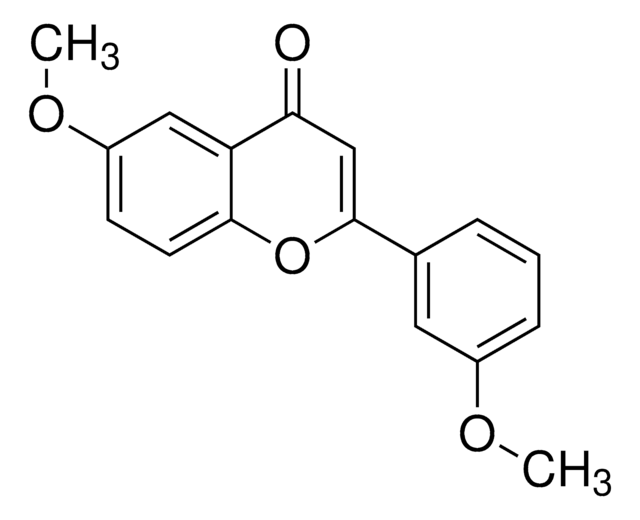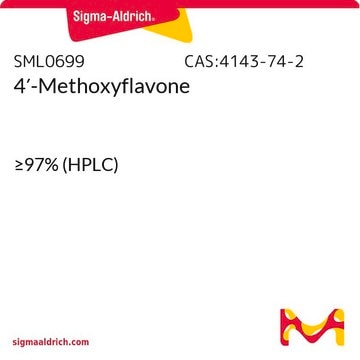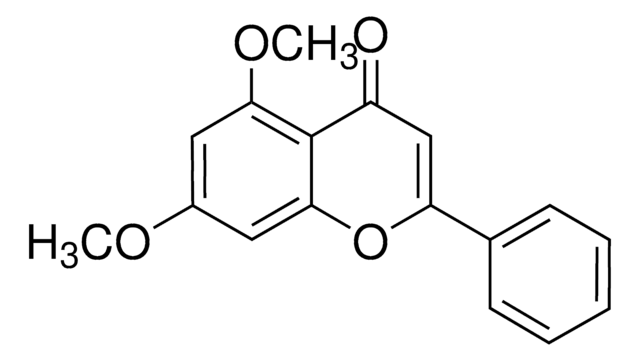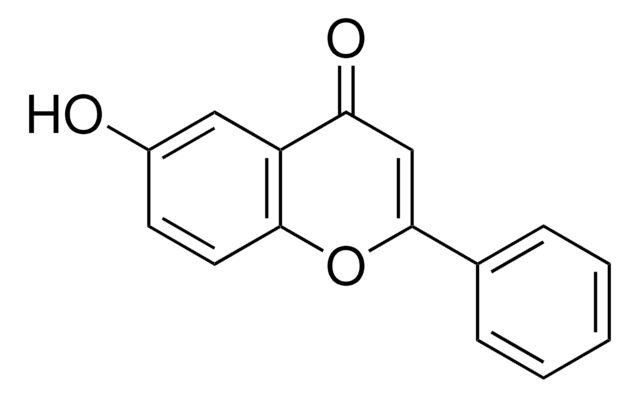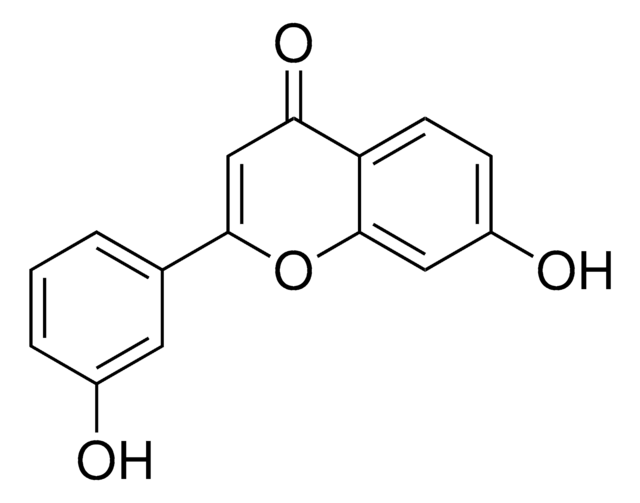About This Item
Wzór empiryczny (zapis Hilla):
C16H12O3
Numer CAS:
Masa cząsteczkowa:
252.26
Numer WE:
Numer MDL:
Kod UNSPSC:
12352100
Identyfikator substancji w PubChem:
NACRES:
NA.22
Polecane produkty
Próba
99%
Postać
solid
mp
163-165 °C (lit.)
ciąg SMILES
COc1ccc2OC(=CC(=O)c2c1)c3ccccc3
InChI
1S/C16H12O3/c1-18-12-7-8-15-13(9-12)14(17)10-16(19-15)11-5-3-2-4-6-11/h2-10H,1H3
Klucz InChI
XZQLSABETMKIGG-UHFFFAOYSA-N
informacje o genach
rat ... Gabra2(29706)
Opis ogólny
6-Methoxyflavone is one of the methoxyflavone isolated form Pimelea decora. Synthesis of 6-methoxyflavone from p-dihydroxybenzene has been reported.
Zastosowanie
6-Methoxyflavone may be employed in the following studies:
- As internal standard for the analysis of polyphenolic content of in-vitro-cultured chestnut shoots.
- Synthesis of biflavonoids, rac- and meso-6,6-dimethoxy-2,2-biflavanones.
- As internal standard for the separation of phenolic compounds in the apricot tissue by HPLC.
This page may contain text that has been machine translated.
Kod klasy składowania
11 - Combustible Solids
Klasa zagrożenia wodnego (WGK)
WGK 2
Temperatura zapłonu (°F)
Not applicable
Temperatura zapłonu (°C)
Not applicable
Środki ochrony indywidualnej
Eyeshields, Gloves, type N95 (US)
Certyfikaty analizy (CoA)
Poszukaj Certyfikaty analizy (CoA), wpisując numer partii/serii produktów. Numery serii i partii można znaleźć na etykiecie produktu po słowach „seria” lub „partia”.
Masz już ten produkt?
Dokumenty związane z niedawno zakupionymi produktami zostały zamieszczone w Bibliotece dokumentów.
J. L. Fernandez-Lorenzo et al.
Tree physiology, 19(7), 461-466 (2003-03-26)
The phenolic contents of eight in-vitro-cultivated chestnut clones (Castanea sativa Mill. and C. sativa x C. crenata Siebold & Zucc. hybrids) were analyzed both qualitatively and quantitatively. The aim of the work was to identify potential phenolic markers of: (i)
Pilar Errea et al.
Physiologia plantarum, 112(1), 135-141 (2001-04-25)
Graft compatibility has been studied in vitro using callus tissues of apricot (Prunus armeniaca) and different Prunus rootstocks to form scion/rootstock combinations with different degrees of graft compatibility. In these species, incompatibility is manifested by a breakdown of the trees
The constituents of Australian Pimelea species. II. The isolation of unusual flavones from P. simplex and P. decora.
Freeman PW, et al.
Australian Journal of Chemistry, 34(8), 1779-1784 (1981)
Photohydrodimerization of 6-Methoxyflavone to 6, 6′-Dimethoxy-2, 2′-Biflavanones.
Chen A-H, et al.
J. Chin. Chem. Soc., 51(6), 1389-1394 (2004)
Sara Serra et al.
Foods (Basel, Switzerland), 9(10) (2020-10-18)
The rising interest in beneficial health properties of polyphenol compounds in fruit initiated this investigation about biochemical composition in peach mesocarp/exocarp. Biochemical evaluation of phenolic compounds and ascorbic acid were quantified through high-performance liquid chromatography (HPLC) in relation to three
Nasz zespół naukowców ma doświadczenie we wszystkich obszarach badań, w tym w naukach przyrodniczych, materiałoznawstwie, syntezie chemicznej, chromatografii, analityce i wielu innych dziedzinach.
Skontaktuj się z zespołem ds. pomocy technicznej